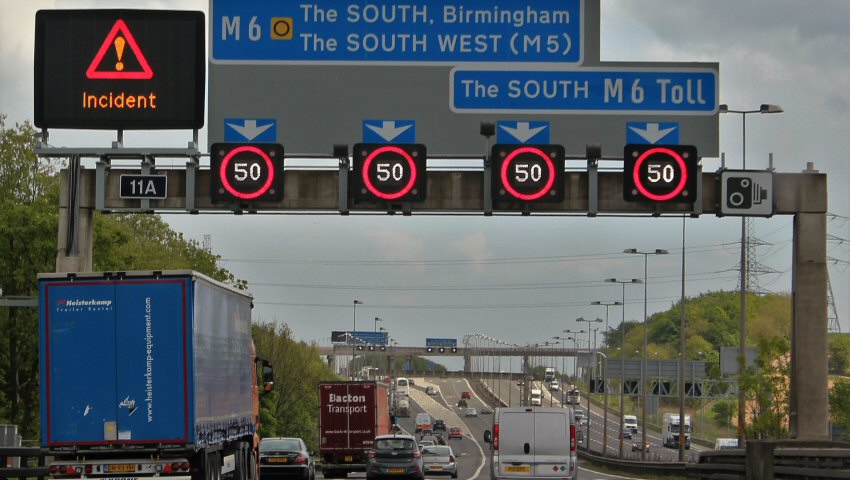
Are smart motorways stupid?
When, in June 2019, a Ford Transit van and a Ford Focus had a minor collision on the M1 near Rotherham, the drivers stopped their vehicles to exchange details. What they hadn’t realised was that the hard shoulder, where they had briefly parked up, was on a stretch of smart motorway, and had been turned into a ‘live running’ lane. Six minutes later, both men - Jason Mercer and Alexandru Murgeanu – were killed by a Mercedes lorry, travelling at 56mph.
The tragic incident is one of several which underpin an increasing level of concern about the viability of smart motorways. In fact, as recently as last week (January 18, 2021), the coroner at the inquest into the deaths of the two men said smart motorways ˜present an ongoing risk of future deaths˜, while the South Yorkshire PCC (police and crime commissioner), Alan Billings, denounced the technology as ˜inherently unsafe and dangerous and should be abandoned˜.
So, what is the case for and against smart motorways? At Desperateseller.co.uk, we thought readers might like to be reminded of some of the basic arguments, both pro and con. So, here are three of each - you can then make your own mind up.
Pro 1: They increase traffic flow
The obvious way to increase traffic flow on a motorway, of course, is to add lanes. To do this, you can either build from scratch (expensive time consuming), of make use of existing spaces, such as the hard shoulder. That (using the hard shoulder) is the basic idea behind a smart motorways – the ‘smart’ bit being that the ‘new’ lane (called a ‘live-running’ lane) can be easily deactivated in certain scenarios, such as if a stopped vehicle is detected. There are also emergency refuge areas that ailing vehicles can use. Does it work? In general, yes - Highways England figures from 2018/19 showed that journey reliability was improved by 22% on roads with smart sections.
Pro 2: They save money and protect the environment
As mentioned above, using hard shoulders reduces expenditure on new lanes, thereby cutting cost to the taxpayer. A less obvious saving is the environmental one - improved control of traffic flow and speed mitigates stop-start movement and reduces emissions. It also cuts the wear and tear on cars.
Pro 3: They save lives from hard shoulder misuse
Hard shoulders are dangerous places. Why? Partly because many people use them to check their phones, consult their satnav - or even have a nap! And even vehicles that are ‘legitimately’ stopped on a hard shoulder – due, for example, to mechanical breakdown – are in real danger of collision. In fact, incredible though it may seem, 40% of motorway incidents involving a stopped vehicle occur on a hard shoulder. On the other hand, being stranded in a live lane, while unpleasant, isn’t necessarily very dangerous if the scene were protected by electronic warnings (and those warnings were respected!). This danger can be further reduced by the use of emergency refuge areas, separated from the road.
Con 1: Casualties in all-lanes-running conditions
The advantages of Pro 3 are contingent upon an effective system for detecting stopped vehicles. And, so far, the evidence that such a system exists is very weak. Recent crashes and near-misses involving stranded vehicles on all-lanes-running motorway stretches have cast real doubt on the validity of the smart motorway concept. In fact, there are increasing calls, from MPs and others, for the rollout of these roads to be stopped, and the AA won’t let its crews stop to help motorists until they’re towed to a refuge area. While proponents of the smart motorway claim that better stopped-vehicle detection systems are on being implemented, the incident stats say otherwise. Plus, the use of refuge areas is considerably different to the initial proposals - at the time of the smart motorway trials, refuge areas were four times closer together than on some later installations.
Con 2: Emergency refuge areas
As we’ve just mentioned in Con 1, an effective smart motorway needs more emergency refuge areas, so that fewer people stop in-lane. But, even if you had a lot more refuge areas, there’s still the issue of rejoining the main highway– which can be dangerous, as refuge areas are limited in space. Hard shoulders offer more of a run-up when it comes to rejoining running lanes.
Con 3: Educating users
Despite the publicity they get, smart motorways are a source of confusion for many road users. Many don’t know that they can use the hard shoulder, or understand about emergency refuge areas, while others worry about sudden speed limit changes. “Some hard shoulders on dynamic smart motorways are only open to running traffic during the morning and evening peaks, but this catches out some drivers when their routine changes,” Highways England CEO, Jim O’Sullivan told the Commons Transport Select Committee in 2019. “When we close it at other times of the day, people still drive down it,” he added. In other words, smart motorways represent a land of confusion.
So, after all that, what do you think? Should SMs be ditched, or should the idea be pursued? For what it’s worth, a recent survey of motoring magazine readers showed a general consensus for continuing their development, subject to three conditions: (a) better education of drivers, (b) the use of more frequent refuge areas, and (c) better stopped-vehicle detection.
Finally, if you’re looking to do something unarguably smart, why not check out our used cars section You’ll find great deals that suit all needs and tastes!













